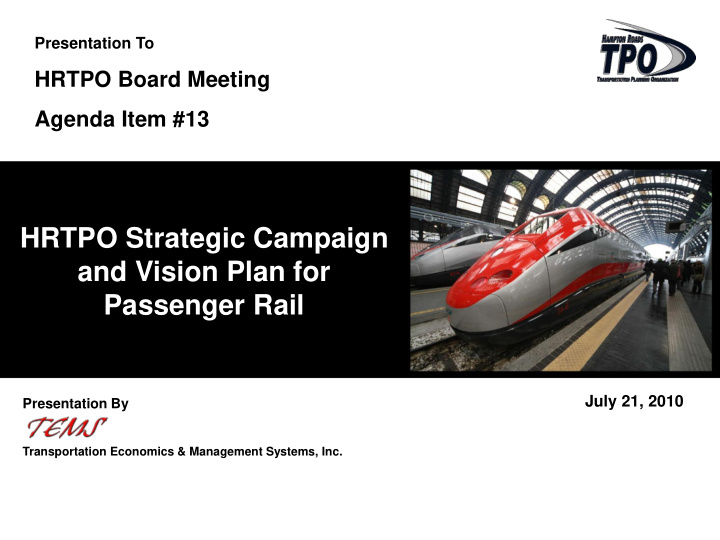



Presentation To HRTPO Board Meeting Agenda Item #13 HRTPO Strategic Campaign and Vision Plan for Passenger Rail July 21, 2010 Presentation By Transportation Economics & Management Systems, Inc.
Vision Plan Phase 1: Study Objectives 1. Hampton Roads Transportation Planning Organization – Resolution 2009-05 The Hampton Roads TPO endorses – Designation of a “High - Speed Rail” corridor along the NS/Route 460 corridor. Enhancement of the Intercity Passenger Rail service along the CSXT/I-64 corridor. 2. USDOT FRA Public/Private Partnership Potential – POSITIVE OPERATING RATIO POSITIVE COST BENEFIT RATIO 1 TEMS, Inc.
How Important is our Corridor? Washington-Richmond-Hampton Roads corridor is one of the top 200-mile High-Speed Rail corridors in the country. The corridor has independent utility The corridor provides connectivity with the Southeast and Northeast corridors. 350 Philadelphia-Harrisburg- Pittsburg 300 Cleveland-Columbus- Corridor Length (mile) Cincinnati 250 Miami-Orlando Dallas-Houston Portland-Seattle 200 Washington- Charlotte-Raleigh Atlanta-Birmingham Hampton Roads 150 Cleveland-Detroit Cleveland-Pittsburg 100 Orlando-Tampa 50 2 4 6 8 10 12 14 Population (million) 2 TEMS, Inc.
DRPT has initiated the development of the corridor using conventional technology This includes - Introducing rail service to South Hampton Roads Planning to upgrade service to a maximum of 90-mph Developing critical connections for Southeast High- Speed Rail (SEHSR) and Northeast (NEC) corridors Increasing frequencies to 6 trains on the NS/Route 460 segment, and 3 trains on the CSXT/I-64 segment Improving access to Richmond Main Street Station Developing new stations along the routes This lays the foundations for developing an effective high-speed rail program 3 TEMS, Inc.
High-Speed Rail Eliminates Annual Subsidy Increasing speed to 110-mph produces a positive operating ratio that meets FRA financial criteria. STEP 3 STEP 3 STEP 4 STEP 4 CSXT/ CSXT/ NS/ NS/ CSXT/ CSXT/ NS/ NS/ 0 0 I-64 I-64 Route 460 Route 460 I-64 I-64 Route 460 Route 460 2025 Operating Ratio 2025 Operating Ratio 1.06 1.06 1.19 1.19 1.52 1.52 1.51 1.51 4 TEMS, Inc.
High-Speed Rail in the Washington- Richmond-Hampton Roads Corridor Achieves FRA Financial and Economic Funding Criteria Positive Operating Ratio with Operating Surplus Positive Cost Benefit Ratio – Good for the Corridor – Good for Virginia – Good for the Country 5 TEMS, Inc.
Capital Cost and Funding Capital Cost – Steps 3 and 4 Cost $3 – 6 Billion respectively Funding Approach - Two Options 80 percent of funding from USDOT FRA, Local match from station development/parking 30-60 percent from public-private partnership (P3), Design, Build, Own, Operate, Maintain and Finance (DBOOM-F) 6 TEMS, Inc.
Benefits 1: Both Corridors have High-Speed Rail Potential: Travel Times and Train Frequency can be dramatically improved NS/Route 460: 150-mph CSXT/I-64: 110-130-mph Travel Times 2:05 2:00 Train Frequencies 6 – 8 Trains 14 – 16 Trains 7 TEMS, Inc.
Benefits 2: The System Largely Diverts Auto Traffic; Reducing Congestion on highways I-64 and I-95 CSXT/I-64 Corridor NS/Route 460 Corridor Natural Growth Natural Growth Induced Demand Induced Demand 1.6% 1.9% 9.5% 7.6% Diverted Demand Diverted Demand 88.9% 90.5% “85 - 90 Percent of Rail Demand is from Auto” 8 TEMS, Inc.
Benefits 3: Joint Development Potential is Considerable at Stations Proposed San Jose High-Speed Rail Station Proposed Sacramento High-Speed Rail Station 9 TEMS, Inc.
Benefits 4: Supplyside Impacts are Very Significant Productivity jobs Income ($) Property Values ($) (person years of work) Washington, DC – 430-480 thousand 3.5 – 4 billion 0.5-0.8 billion North Virginia Area Richmond – 230-250 thousand 1.2 – 1.5 billion 0.15-0.2 billion Petersburg Area Norfolk- 0.8 – 1 billion 140-170 thousand 0.8-1 billion Newport News Area 5.5 – 6.5 billion 1.45 – 2 billion Total 0.8-0.9 million 10 TEMS, Inc.
Conclusions HRTPO Objectives can be achieved High-Speed Rail generates very significant benefits for the corridors communities The Washington-Richmond-Hampton Roads corridor is of national importance High-Speed Rail generates very significant benefits for the corridors communities The corridor is a critical element of the Southeast High-Speed Rail (SEHSR) and Northeast Corridor (NEC) 11 TEMS, Inc.
Challenges of Developing the High-Speed Rail Corridor Long-term HSR Funding – Initial USDOT $8B funding but national program opportunities require much more. FRA/Environmental Processes – Process for HSR implementation is lengthy and cumbersome. More rules being added to implementation / time to develop / programming. In the change of rules the lack of a designated “Virginia” HSR corridor and HSR Service Plan hinder applying for HSR funds. 12 TEMS, Inc.
Recommendations VA Department of Rail and Public Transportation should continue the implementation of the Intercity Rail Alternatives Steps 1 & 2. Pursue USDOT designation of the Washington-Richmond-Hampton Roads HSR corridor as a Virginia corridor having independent utility (e.g., the Chesapeake Bay corridor). Complete the High-Speed Rail Vision by developing the Vision Plan/Service Plan for FRA Funding. Consider implementing High-Speed Rail with a Public-Private Partnership Process 13 TEMS, Inc.
Thank You 14 TEMS, Inc.
Recommend
More recommend